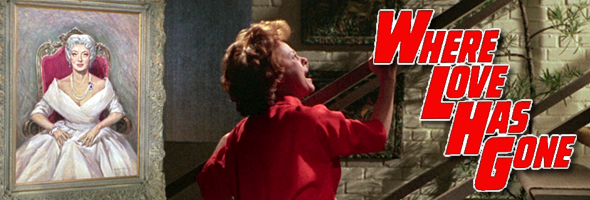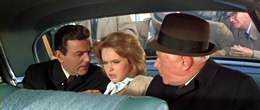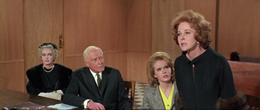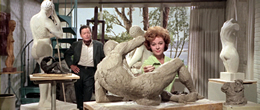


Death by chisel at the hands of an underage jail bait teen is just the start of this outrageously trashy soap opera, a widescreen opus concocted by Paramount Pictures hot off the same year's earlier success of The Carpetbaggers. That film's director, Edward Dmytryk, was brought back here along with the same screenwriter, John Michael Hayes (Rear Window), to adapt another sexy, violent novel by Harold Robbins. For those who don't know, Robbins was one of the reigning kings of paperback airport novels filled with glamorous peo ple doing filthy, sordid things to each other, exemplified in later, more graphic film adaptations like The Adventurers, The Betsy, and the awe-inspiring The Lonely Lady. This one still stands up well against them all, however, thanks in no small part to the catty relationship between real-life adversaries Susan Hayward and Bette Davis, both ripping the scenery to shreds for two hours.
ple doing filthy, sordid things to each other, exemplified in later, more graphic film adaptations like The Adventurers, The Betsy, and the awe-inspiring The Lonely Lady. This one still stands up well against them all, however, thanks in no small part to the catty relationship between real-life adversaries Susan Hayward and Bette Davis, both ripping the scenery to shreds for two hours.
Though the makers denied it at the time, everyone knew this story was inspired by one of Hollywood's most notorious scandals, the 1958 stabbing death of Lana Turner's lover, Johnny Stompanato, by her daughter, Cheryl Crane. Here the big moment opens the film as sixteen-year-old Danny (Heatherton, shortly before her sex kitten days with the Rat Pack) is hauled into juvenile hall after shoving a chisel into the belly of one of the paramours of her mother, famous San Francisco sculptress Valerie (Hayward, pre-Valley of the Dolls). In flashbacks Valerie first meets her army major husband, Luke (Mannix's Connors), who wins her over by standing up to her domineering and manipulative mother (Davis), who wrecks their marriage by defeating Mike's attempts at an independent business. Danny is born and grows up in a strained household as her dad becomes a drunk and her mom turns into an alley cat, with sex providing the only way for her to produce great sculptures. No, really! That's actually spelled out in the dialogue by Valerie's ex, an art critic played by Star Trek's DeForrest Kelly. And speaking of dialogue, here's a standout moment when Valerie gets caught cheating by hubby that will have Somet hing Weird fans delirious with glee: "I've heard about the
hing Weird fans delirious with glee: "I've heard about the m. I've laughed about them. I've even joked about them. But I never thought I'd end up married to one! You're not a woman; you're a disease!" Back in the present day, debates about Danny's virginity lead to a big court hearing about Valerie's abilities as a mother, complete with big speeches and a bigger violent climax that will have most viewers hitting the rewind button in disbelief.
m. I've laughed about them. I've even joked about them. But I never thought I'd end up married to one! You're not a woman; you're a disease!" Back in the present day, debates about Danny's virginity lead to a big court hearing about Valerie's abilities as a mother, complete with big speeches and a bigger violent climax that will have most viewers hitting the rewind button in disbelief.
A big, unhealthy banquet of crazed plot turns and overheated characters, Where Love Has Gone delivers huge heapings of entertainment in less than two hours. One can only wonder how much of this was being taken seriously by controversial blacklisted director Dmytryk, who later reteamed with Heatherton for the even nuttier gothic soaper Bluebeard in '72. It's all lovingly shot in opulent scope and looks pretty similar to the films Turner herself was making around the same time, with tons of wood paneling and questionable artwork all over the screen. Enemies or not, it's great fun seeing Hayward and Davis square off in their scenes together, easily overshadowing the rest of the cast (which also includes a slew of character actors like Whit Bissell, George Macready, and Ann Doran). On top of that you get a string-heavy score by Walter Scharf, complete with a sudsy theme song that somehow managed to wrangle an Oscar nomination.
Seen on TV and VHS for years in a terrible pan-and-scan version that demolished almost every shot in the film, Where Love Has Gone received its first-ever widescreen transfer from Olive Films in 2010 on DVD, followed by a Blu-Ray in 2012 (both containing just the main feature). Definitely go for the Blu-Ray if you can; while this film has that soft, powdery look familiar from many glossy titles from the period, it's a colorful and clean presentation with mild and natural levels of grain and a nice level of detail considering how bright and flat the lighting is throughout the film. Either way, it's nice to be able to appreciate the very wide compositions, which consistently make use of extreme edges of the frame for dramatic compositions. The mono audio sounds sharp as well, including that darn song blasting out over the main and closing titles. A truly astonishing experience if you like a heavy dose of (possibly unintentional) camp with your big-studio helpings of soap and sin.
![]()